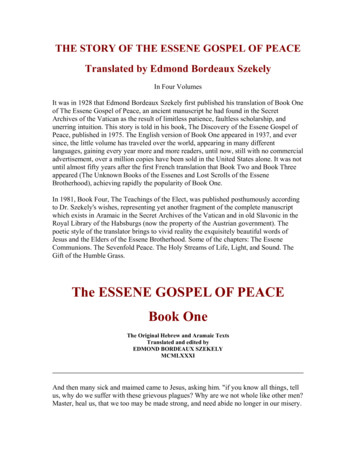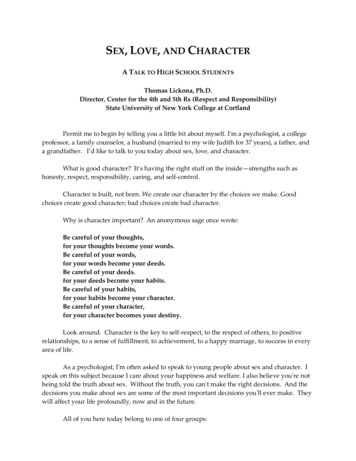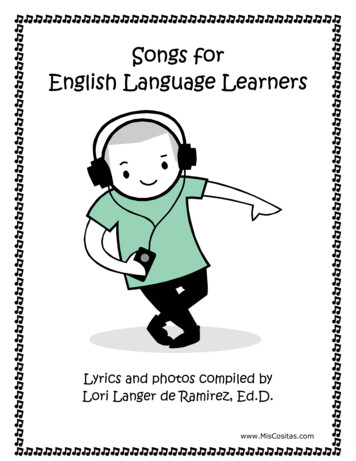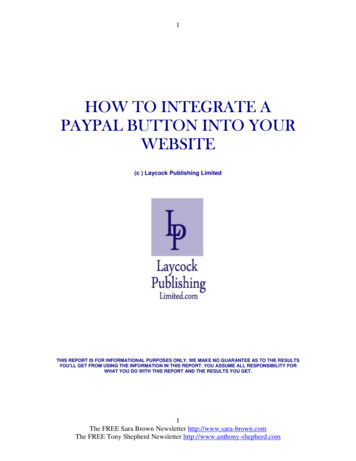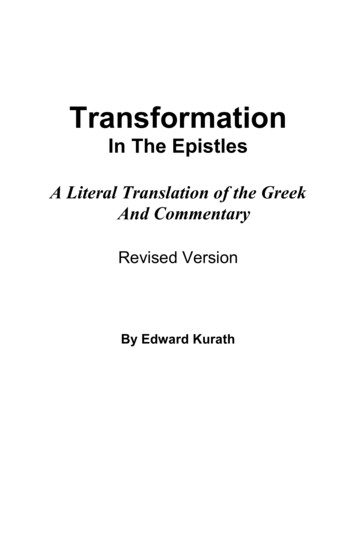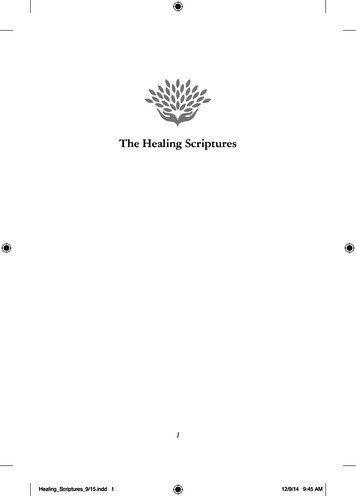
Transcription
Public Disclosure AuthorizedPolicy Research Working PaperPublic Disclosure Authorized7257You Are What (and Where) You EatCapturing Food Away from Home in Welfare MeasuresGabriela FarfanMaria Eugenia GenoniRenos VakisPublic Disclosure AuthorizedPublic Disclosure AuthorizedWPS7257Development Research GroupSurveys and Methods Team&Poverty Global Practice GroupMay 2015
Policy Research Working Paper 7257AbstractConsumption of food away from home is rapidly growing across the developing world. Surprisingly, the majorityof household surveys around the world haven not keptup with its pace and still collect limited information onit. The implications for poverty and inequality measurement are far from clear, and the direction of the impactcannot be established a priori, since consumption of foodaway from home affects both food consumption and thepoverty line. This paper exploits rich data on food awayfrom home collected as part of the National HouseholdSurvey in Peru, shedding light to the extent to which welfare measures differ depending on whether they properlyaccount for food away from home. Peru is a relevant context, with the average Peruvian household spending 28percent of their food budget on food away from homeby 2010. The analysis indicates that failure to account forthe consumption of food away from home has importantimplications for poverty and inequality measures as well asthe understanding of who the poor are. First, accountingfor food away from home results in extreme poverty ratesthat are 18 percent higher and moderate poverty rates thatare 16 percent lower. These results are also consistent, infact more pronounced, with poverty gap and severity measures. Second, consumption inequality measured by theGini coefficient decreases by 1.3 points when food awayfrom home is included, a significant reduction. Finally,inclusion of food away from home results in a reclassification of households from poor to non-poor status and viceversa: 20 percent of the poor are different when the analysis includes consumption of food away from home. Thiseffect is large enough that a standard poverty profile analysisresults in significant differences between the poverty classification based on whether food away from home is includedor not. The differences cover many dimensions, includingdemographics, education, and labor market characteristics.Taken together, the results indicate that a serious rethinking of how to deal with the consumption of food awayfrom home in measuring well-being is urgently needed toproperly estimate and understand poverty around the world.This paper is a product of the Surveys and Methods Team, Development Research Group; and the Poverty Global PracticeGroup. It is part of a larger effort by the World Bank to provide open access to its research and make a contribution todevelopment policy discussions around the world. Policy Research Working Papers are also posted on the Web at http://econ.worldbank.org. The authors may be contacted at gfarfan@worldbank.org, mgenoni@worldbank.org, and rvakis@worldbank.org.The Policy Research Working Paper Series disseminates the findings of work in progress to encourage the exchange of ideas about developmentissues. An objective of the series is to get the findings out quickly, even if the presentations are less than fully polished. The papers carry thenames of the authors and should be cited accordingly. The findings, interpretations, and conclusions expressed in this paper are entirely thoseof the authors. They do not necessarily represent the views of the International Bank for Reconstruction and Development/World Bank andits affiliated organizations, or those of the Executive Directors of the World Bank or the governments they represent.Produced by the Research Support Team
You Are What (and Where) You Eat:Capturing Food Away from Home in Welfare Measures 1Gabriela Farfan, Maria Eugenia Genoni, and Renos VakisKeywords: poverty, inequality, food consumption, welfare measurement, data collection.JEL codes: O1, C81, I31, I32.1We are grateful to colleagues at the National Statistics Office (INEI) in Peru, and especially Nancy Hidalgo,Lucia Gaslac, and Oscar Perfecto for their countless help and advice during the data preparation and analysis. Thepaper benefited from comments from Gero Carletto, Dean Jolliffe, Talip Kilic, Nobuo Yoshida, members of theNational Poverty Commission in Peru as well as participants of the 2014 Food Consumption Conference in Rome andthe Side Event on Improving Food Consumption Measurement in National Household Surveys at the 46th Session ofthe UN Statistical Commission. Financial support for this research has been received from the World Bank’s KCPwindow as well as FAO’s funding on food consumption research. Contacts: gfarfan@worldbank.org andmgenoni@worldbank.org and rvakis@worldbank.org.
1. IntroductionConsumption patterns are rapidly changing across the developing world, with prepared andpackaged meals and meals consumed outside the home taking an ever growing share of thehouseholds’ food budget. Furthermore, with rising incomes, urbanization, and women entering thelabor force, among various reasons, this trend is expected to persist as economies transition to middleincome status (USDA; Smith, 2013).In spite of its growing participation in households’ budgets, food away from home (FAFH)remains one of the least studied aspects of food consumption. The vast majority of the literaturecorresponds to studies in the developed world, where the rising trend of eating out started a fewdecades ago. The main focus of that literature has been on public health issues, initially motivated bythe high and positive correlation between eating out and obesity trends, and later also connected toother chronic diseases developed later in life (Burns et al., 2002; Guthrie et al., 2002; Kant andGraubard, 2004; Le Francois et al., 1996; Lin and Guthrie, 2012; Binkley et al., 2000). While causalityhas been hard to prove, sharp differences in the caloric and nutritional composition between foodproduced in commercial outlets and home-made food have been well documented, and interest indeveloping food-based dietary guidelines is increasing (Kearney et al., 2001; O’Dwyer et al. 2005).The health consequences of eating out are also of interest in developing countries, but the roleof food consumption in this setting has a much broader and deeper scope. 2 Food consumption playsan instrumental role in the design and monitor of development policy at the local, national, and globallevels. Poverty, food security, health, and nutrition, lie at the heart of the development agenda, andthe computation and monitoring of indicators that track those welfare dimensions rely heavily on foodconsumption or expenditure data. While data on household consumption or expenditure data hasdramatically increased over the last few decades 3, appropriate data on FAFH patterns are lacking, andthe consequences of miss-measurement of food consumption on our assessment and understandingof these major policy areas are largely unknown.2With obesity increasingly becoming a pressing health issue in some middle-income countries, the linkbetween eating out and obesity is also drawing attention in the developing world (Lozada et al., 2008; Bezerra andSichieri, 2009).3The 1990 World Development Report on Poverty published by the World Bank relied on data from only22 countries, and no country had more than one survey. Today, there are more than 850 surveys from 125 countrieswith consumption or expenditure data (Ravallion and Chen, 2011).2
A few small-scale studies – with the exception of Liu et al. (2006) - have documented theincreasing contribution of FAFH to diet quantity, quality, and diversity, among various populationgroups across different developing countries. For example, FAFH has been found to contribute to asmuch as 36% of the daily energy intake among men in urban Kenya, and 59% among market womenin urban Nigeria (van’t Riet et al. 2002; Oguntona and Tella 1999). Among the younger population,FAFH contributes, for example, to 18% and 40% of daily energy intake among Chinese children andschool-going adolescents in Benin, respectively (Liu et al., 2006; Nago et al., 2010).However, most nationally representative household surveys have not kept up with the paceand collect very limited information on FAFH. A number of conceptual and practical challengesemerge. The first challenge in collecting information on FAFH has to do with the complexity that theconcept “food away from home” entails. On one hand, FAFH can refer to food produced outside,regardless of whether the food is consumed outside or inside the home. In this case, take-out mealswould be considered FAFH. Alternatively, it can refer to food consumed outside irrespective of theorigin of the food. Under this scenario, home-made meals consumed at work or school would be acomponent of FAFH. While there is a general preference towards defining FAFH based on the placeof preparation of the food, a clear protocol that takes into account all these different pieces is requiredto be well defined regardless of the concept that is adopted. A second element to consider whencollecting information on FAFH is snacks, which in modern eating habits are more likely to beconsumed outside the home. Finally, there can be different modes of acquisition of the food, includingpurchased food or food received in kind, each of which can further originate from multiple sourcessuch as commercial establishments, social programs, and other households, among others. In all,integrating FAFH information in household surveys is complex, and in practice few countries haveaddressed these survey design issues adequately.In a recent comprehensive assessment on the relevance and reliability of food data collectedin household consumption and expenditure surveys in developing countries, Smith et al. (2014) takethe most recent nationally representative household survey from each developing country and analyzethe content of the questionnaire. The final sample consists of 100 surveys, which represent 70% ofthe developing countries. Among other quality indicators, the coverage and detail of FAFH data isanalyzed. Following a very lax definition of FAFH, which consists of checking whether “any fooditem in the food list itself, the title of the section in which it is found, or a question regarding the item,contains words such as consumed out, restaurant, consumed away, and the like”, it turns out that 90%3
of the surveys do consider FAFH in some form. However, when looking more deeply into the waythis information is collected we find a huge variation in quality. More detailed statistics reported bySmith et al. (2014) paint far from optimal picture in the collection of FAFH data. For example, aquarter of the surveys aim to capture all related household consumption from FAFH using just onequestion, while only one in five surveys considers multiple places of consumption. With respect tosnacks, only 35 percent takes them explicitly into account, and close to half of the surveys do notinclude FAFH received in kind. 4Recent analysis from India and Brazil provide new evidence on the implications that notaccounting for FAFH can have on food security analysis. In the case of India, Smith (2013) arguesthat the great Indian calorie debate originated by an apparent increase in undernourishment at thetime of falling poverty rates can be partly explained by inaccurate data on calorie intake due to the lackof measurement of FAFH. Similarly, work by Borlizzi and Cafiero (2014) in Brazil shows how thedistribution of food consumption by income strata changes once food consumed at school is takeninto account. In fact, they show that proper account for food received through a school feedingprogram targeted at the poorer strata of the population results in a more equal distribution of foodconsumption than previously thought, allowing for a long due revision of the FAO assessment ofundernourishment in Brazil.In this paper, we evaluate the impact of accounting FAFH on poverty and consumptioninequality estimates in Peru. 5 To do this, we simulate a situation where we move from a world whereFAFH is not accounted for to one where it is. In the process, we show that from a theoretical pointof view, the direction of the effect on poverty or inequality of properly accounting for FAFH cannotbe predicted ex-ante.In addition to what information to elicit, how that information is elicited is also of great importance. In thecase of FAFH, the informant plays a critical role. While most surveys apply the consumption or expenditure moduleto a household informant, this strategy is expected to result in much higher measurement error when it comes toreporting FAFH, because by definition most of this consumption takes place outside the house (and therefore out ofsight from the informant). According to Smith et al. (2014), only 17 percent of the surveys collect FAFH at theindividual level.5A few papers analyze the impact of different aspects of survey design on total expenditures, and povertyand inequality measures (Backiny-Yetna et al. 2014; Beegle et al. 2012; Deaton and Grosh, 2000; Gibson et al., 2003;Joliffe, 2001; Pradhan, 2001). The work by Backiny-Yetna et al. (2014) is the only one to look in particular at theimpact of food consumption data collection methods on poverty and inequality.44
Operationally, we exploit a rich module on FAFH collected as part of the multi-year NationalHousehold Survey in Peru (ENAHO) to shed light on the extent to which welfare measures may differbased on whether FAFH accounted for. Peru is a relevant context to study this question since FAFHis fairly widespread and increasing. In 2013, the average Peruvian household spent about 28 percentof their food budget on FAFH.To assess the impact on poverty measurement, we follow the official methodology adoptedby the National Institute of Statistics and Informatics (INEI) and start with a scenario where FAFHis not accounted for. Then, we use this estimate as the benchmark over which the impact of includingFAFH is assessed. Peru introduced a big methodological change in 2010, and therefore we use thatyear for our analysis. The definition of FAFH adopted by INEI includes all food prepared outside thehome. We estimate the effect of FAFH on the poverty rate, the poverty gap, and the severity ofpoverty. Then, to evaluate the effect on consumption inequality we compute the Gini coefficient basedon the expenditure distribution with and without FAFH. Finally, we go beyond a summary welfaremeasure and analyze whether lack of accounting for FAFH changes our understanding andcharacterization of the poor population, i.e. we analyze how the profile of the poor changes once wetake into account FAFH.Our analysis indicates that failure to account for FAFH has significant and sizable effects onpoverty and inequality indices and our understanding of poverty in general. First, proper accountingof FAFH results in extreme poverty rates that are 18 percent higher and moderate poverty rates thatare 16 percent lower than the scenario without FAFH. The increase in the extreme poverty rate isdriven by the fact that the cost of the food basket is higher when FAFH is taken into account (whichraises the poverty line), an effect that outweighs the increase in measured consumption that resultsfrom accounting for FAFH (which increases household consumption). The increase in the cost of thefood basket is explained by the higher per calorie costs derived from FAFH relative to food preparedat home.Second, and by contrast, the moderate poverty rate falls because the increase in resources thatcome from accounting for FAFH consumption offsets the increase in the moderate poverty line.When we split FAFH into take-out food, food prepared and consumed outside by children, and foodprepared and consumed outside by adults, we find that all these effects are driven by adultconsumption outside the home. These effects are also consistent, in fact more pronounced, when we5
compute changes in the poverty gap and severity of poverty. Finally, consumption inequality is lowerwhen FAFH is accounted for. The Gini coefficient falls by 1.3 points, an effect explained by the higherrelative participation of FAFH over total household expenditures at the lower end of the distribution.Finally, accounting for FAFH also generates a re-ordering of households along theconsumption distribution. Overall, 41 percent of the population changes their relative ranking whenmeasured by the percentile of the expenditure distribution they belong under each scenario. Thisimplies that not including FAFH in the poverty estimates can lead to an important re-classification ofthe poor population, which has a significant impact on the profile of the poor. In our analysis, we findthat 20 percent of the population classified as poor when FAFH is ignored is no longer poor onceFAFH is accounted for. Furthermore, this substantial change in the composition of the poor translatesinto changes in the typical profile of the poor when measured by demographic and socio-economiccharacteristics. We finally discuss some implications for survey design and future research.The remaining of the paper is organized as follows: Section 2 connects FAFH to welfare anddiscusses the impact that FAFH has on the poverty and inequality indicators analyzed in this paper aswell as on the profile of the poor; Section 3 introduces the setting and data, including details on theofficial methodology INEI implements to compute poverty statistics; Section 4 presents the results;and Section 5 concludes.2. Integrating Food Away from Home in Welfare AnalysisWhile it is well understood that welfare entails multiple dimensions, household expenditure –consumption - has long been considered a flagship summary welfare indicator. It responds to the viewthat well-being constitutes the command over household commodities, and therefore consumptionpatterns, if well-measured and properly adjusted for time and space price differences, can properlytrack utility levels. 6,76An alternative approach to well-being consists of asking whether people are able to obtain specific typesof consumption goods, such as food, health or education (Haughton and Khandker, 2009). Measuring well-being inthat way requires selecting a marker for each dimension of interest, as there is little agreement over how to constructa multidimensional index in an objective way, or if there is any value to such index at all. Therefore, the monetaryapproach to the measurement of well-being continues to take a central place in development policy, especially inpoverty analysis.7An alternative monetary indicator of welfare is income, which is mostly used in developed countries. Incontrast, concerns with underreporting and the high variability of income in developing settings have made6
In developing countries, food consumption represents a high share of total consumption, andtherefore special interest is placed on proper measurement of food consumption. Being a centralwelfare marker, proper measurement of consumption - and food consumption in particular, can havefar reaching implications for welfare analyses. In this work, we focus on the impact that incorporatingFAFH in the measurement of food consumption has on two welfare measures: poverty, understoodas a ‘pronounced deprivation in well-being’, and inequality, which relates to the distribution ofresources (Haughton and Khandker, 2009).2.1 FAFH and Monetary PovertyUnderstanding poverty as pronounced deprivation of well-being, and following the monetaryapproach, the poor are those individuals whose resources – measured through consumption (orincome) - fall below an ‘adequately’ defined threshold. This threshold (the poverty line) is generallyset by measuring the cost of acquiring a basket of goods - the cost of basic needs method. 8Most countries track two levels of poverty: extreme and moderate. Extreme poverty isassociated with a poverty line that reflects the cost of acquiring a food basket that satisfies minimumcalorie requirements, intending to guarantee minimum nutrition needs. Moderate poverty adds to thebasket goods necessary to satisfy other essential needs, such as clothing, health and housing.To compute the extreme poverty line, the usual approach is to select a representative basketof the consumption patterns of a selected group of the population - the reference population. In somecases the reference population corresponds to the segment of the population whose foodconsumption is such that the calories consumed are in the neighborhood of the calorie requirementsin that setting. 9 In the case of Peru, the reference population is selected as those whose overallconsumption levels fall within a somewhat arbitrary distance from the moderate poverty line (on bothconsumption the preferred welfare indicator in developing countries. While most of this work focuses onconsumption, we point to the differences between income and consumption when appropriate.8Other methods do exist to set an absolute poverty line, for example the food energy intake and subjectiveevaluations. The first approach is used when no price information is available but suffers from serious flaws. Thesecond approach is rarely used and is not considered a valid replacement of more objective measures. An alternativeto an absolute poverty line is a relative poverty line, which establishes deprivation relative to the rest of thepopulation. This method is more common among developed countries.9Internationally agreed recommendations on calorie requirement are provided by FAO/WHO/ONU, anddifferentiate by gender, age groups, and physical activity levels.7
directions). Given this population, the food basket is selected such that, consistent with theirconsumption patterns, it satisfies their calorie requirements. 10There is much less agreement over how to incorporate the cost of non-food needs to computethe moderate poverty line. Confronted with the extreme difficulty of selecting a set of goods in anobjective way, the most commonly used method is the indirect approach which draws from the budgetcomposition between food and non-food expenses. The cost of the food basket, together with theshare of total consumption allocated to food can be used to back-up the cost of the non-food basket.A few alternatives exist, the most common of which consists of proportionally expanding the cost ofthe food basket by the inverse of the food budget share (Orshansky coefficient), which tells us by howmany times total consumption exceeds food consumption.Based on the above, it becomes evident that measurement of FAFH can affect povertymeasurement through two channels: the estimate of total consumption and the poverty line. We referto the first effect as an expenditure effect, and the second as poverty line effect. For those countries that useincome to measure poverty, only the poverty line effect applies.To decompose the total impact on poverty into expenditure and poverty line effects, we needto specify a poverty index, i.e. a summary measure of poverty. Let a poverty index P be a function ofthe poverty line 𝑧𝑧, and the consumption distribution, 𝑓𝑓(𝑥𝑥):𝑃𝑃 𝑃𝑃(𝑧𝑧, 𝑓𝑓(𝑥𝑥))Moving from a scenario where FAFH is not accounted for to one where it is, the change inthe poverty index would be: 𝑃𝑃 𝑃𝑃 𝑧𝑧1 , 𝑓𝑓1 (𝑥𝑥) 𝑃𝑃(𝑧𝑧0 , 𝑓𝑓0 (𝑥𝑥))where subscript 0 refers to poverty without FAFH and subscript 1 with FAFH.10Under the first scenario the process is iterative. The poverty lines are first calculated based on aneducated guess of the reference population. If the moderate poverty line does not fall close to the mid-consumptionlevel of the reference population, the reference population is adjusted accordingly and the poverty line recalculated.8
Following Kakwani (2000), we decompose the change in the poverty index into an expenditureeffect and a poverty line effect in the following way: 11 𝑃𝑃 1 𝑃𝑃 𝑧𝑧0 , 𝑓𝑓1 (𝑥𝑥) 𝑃𝑃 𝑧𝑧0 , 𝑓𝑓0 (𝑥𝑥) 𝑃𝑃 𝑧𝑧1 , 𝑓𝑓1 (𝑥𝑥) 𝑃𝑃 𝑧𝑧1 , 𝑓𝑓0 (𝑥𝑥) 21 𝑃𝑃 𝑧𝑧1 , 𝑓𝑓0 (𝑥𝑥) 𝑃𝑃 𝑧𝑧0 , 𝑓𝑓0 (𝑥𝑥) 𝑃𝑃 𝑧𝑧1 , 𝑓𝑓1 (𝑥𝑥) 𝑃𝑃 𝑧𝑧0 , 𝑓𝑓1 (𝑥𝑥) 2In words, the expenditure effect represents the change in the poverty index that results fromthe change in the consumption distribution, holding fixed the poverty line. Similarly, the poverty lineeffect represents the change in the poverty index that results from a shift in the poverty line, holdingconstant the consumption distribution. If one measured the changes sequentially, the magnitude ofeach effect would depend on the order in which they are computed. To avoid such arbitrary choice,the decomposition above measures the expenditure effect as ½ the change due to the shift in theconsumption distribution under the original poverty line and ½ the change due to the same shift inthe consumption distribution computed under the new poverty line. A similar reasoning applies to thepoverty line effect.We proceed next to apply this decomposition to the exercise at hand: the inclusion of FAFH.Expenditure effectMoving from a world without FAFH to one with proper measurement of FAFH has arelatively straightforward impact on overall household consumption: everything else equal, everyhousehold has higher total measured consumption once FAFH is included in the analysis. 12 In otherwords, the whole consumption distribution shifts to the right. The magnitude and shape of this shiftdepends on the importance of FAFH along the ex-ante consumption distribution, i.e. theconsumption distribution without accounting for FAFH. Note that because FAFH and food at homeare substitutes, it is highly likely that the inclusion of a measure of FAFH generates a re-ordering ofhouseholds, changing their position along the consumption distribution (more below).11Kakwani (2000) was concerned with decomposing changes in poverty into an income/growth effect andan inequality effect. Therefore, in that work z is held constant and f(x) is expressed as a function of mean incomeand the Lorenz curve.12In practice, this is true under the assumption that the inclusion of FAFH in the survey does not result inlower reports of other areas of household consumption.9
Whether that translates into a fall in the poverty index depends on its properties. However,among the indices most commonly used, which satisfy a number of basic desirable properties, povertywill go unambiguously down. This happens, for example, if we restrict ourselves to the family ofpoverty indexes that are additively separable, as suggested by Atkinson (1987), and the index satisfythe monotonicity axiom. These indexes can be expresses as the sum of individual poverty indicators,and therefore we easily see that if each of these individual indices weakly decreases with an increase inresources, the poverty index should go down.Poverty line effectWithout going into the specific details involved in the selection of the food basket, we notethat a food basket selected from data that do not accurately represent expenditure patterns may notbe consistent with the behavior of the reference population. 13 The resulting impact on the poverty linecan go two ways:a) The calorie requirements are satisfied at artificially high costs – i.e. the poverty line is higherthan it would be had the data reflect actual consumption patternsb) The calorie requirements are satisfied at artificially low costs – i.e. the poverty line is lowerthan it would be had the data reflect actual consumption patternsFor the case of the extreme poverty line, the direction of the effect will therefore depend onthe relative calorie costs of food items included and excluded in the analysis. By contrast, the changein the moderate poverty line is hard to predict without referring to a specific methodology of how itis defined. If the methodology uses the relative participation of food and non-food items in thehousehold budget to back-up non-food costs, then the impact of introducing FAFH can beestablished. Everything else equal, accounting for FAFH increases the expenditure share allocated tofood. As the participation of food increases, the relative cost of non-food items goes down. In otherwords, for any given cost of the food basket, fewer resources need to be added to get to the moderatepoverty line. 1413An additional effect relates to the fact that the reference population changes across the two scenarios,which may result in different calorie requirements. In our exercises the change in calorie requirements is very low(among all simulations we run, the maximum change we observe is 4 kilocalories on a total of 2,105).14More specifically, the change in the Engel coefficient comes from two sources: the incorporation of FAFHin household expenditures, and the change in the reference population. However, the effect driven by the changein the reference population is significantly smaller relative to the effect driven by the incorporation of FAFH on total10
The overall effect in the moderate poverty line then will be then derived from the net impactof the change in the cost of the food basket and the relative cost of food versus non-food items. Ifthe cost of the food basket goes down, the smaller non-food budget share reinforces this effect andthe poverty line goes down. Otherwise, the effect is ambiguous. It can be that the increase in the costof the food basket outweighs the fall in the relative cost of non-food and the line goes up (though byless than the increase in the extreme poverty line). Alternatively, it can be that the increase in the costof the food basket is less strong than the change in the relative cost of non-food and the moderatepoverty line goes down.As it happened with the expenditure effect, for additively separable poverty indexes satisfyingthe desirable properties the direction of the effect in the poverty line will determine the direction ofthe effect in t
May 05, 2015 · from home collected as part of the National Household Survey in Peru, shedding light to the extent to which wel-fare measures differ depending on whether they properly account for food away from home. Peru is a relevant con-text, with the average Peruvian household spending 28 percent of their foo
